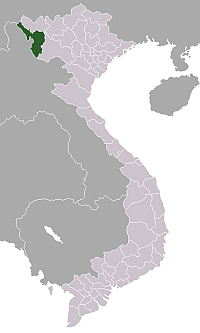Điện Biên Phủ
Dien Bien Phu (Ðiện Biên Phủ) is a medium-sized city located in northwestern Vietnam. It is known for being the scene of the Battle of Điện Biên Phủ, between the Viet Minh and French forces. The battle meant the end of the Indochina War, which would lead to the formation of North Vietnam and South Vietnam.
The city has a population of 125,000. Most are not ethnically Vietnamese, since being in the mountainous interior, it is home to ethnic Thai peoples. One third are Vietnamese along with other groups.
Điện Biên Phủ is in the Muong Thanh Valley. It is the capital of the province of Điện Biên. It is 35 kilometers from the border of Laos.
The biggest tourist attractions are related to the battle: the war museum and the Viet Minh cemetery.
History
When the Japanese evacuated Indochina at the end of World War II, France sought to reestablish its two-hundred-year-old authority over its colonies in Laos, Cambodia, and Vietnam. Laos and Cambodia had reluctantly agreed to remain in the French Union. But in Vietnam the nationalists and communists, under the leadership of the legendary leader Hồ Chí Minh, had founded in 1941 a league for national independence under the name of Viet Minh. But nine years later, after a crushing and humiliating defeat at Điện Biên Phủ, the French had to withdraw from all of Indochina and Southeast Asia.
A year earlier, General Henri Navarre took command of the colonial forces in Vietnam, and carried out a plan to draw the Viet Minh into an open battle, where relentless French firepower should annihilate the guerrilla forces. An airborne operation dropped into the heart of enemy territory a strong garrison of 15,000 elite men, guns, light tanks and napalm-laden planes. The chosen place was Điện Biên Phủ, a town located in a small valley, 300 kilometers west of Hanoi, where the French set up an enormous defensive system, baptizing batteries and units with female names.
But the army of General Võ Nguyên Giáp had experienced great advances in recruitment, training and provisioning, which ended up surprising the French. The Vietnamese, masters of the art of camouflage and sapping work, filled the lines of hills that dominated the French defenses to the east of the entrenched camp with galleries, and installed their modest 200 guns of Chinese origin in such a way that only the mouth came out of the embrasures.
In March they began a bombardment of such intensity and violence that it disconcerted the Europeans and ended up destroying their airstrip, in the lung of Điện Biên Phủ. Immediately, and during 56 days of light artillery siege amid the torrential monsoon rains that had turned the camp into a quagmire, Giáp alternately launched the assault of his infantry, numbering 25,000 men at the time, from trenches and secret tunnels that had been dug from the edges of the jungle. After the French positions fell one after the other under these massive assaults, the last bastions and pockets of resistance were finally dominated on May 7, 1954.
The day after the spectacular victory, the brilliant warlord received a congratulatory telegram from Hồ. He said: "It is indeed a great victory, but it is only the beginning. Signed: Hồ Chí Minh.” Indeed, after the French withdrawal (a nation that would begin to face a new liberation war from then on with disastrous results in Algeria), the intervention of North American advisors (agents of "special warfare") in Vietnam, which had begun just after the end of the war of Korea, an escalation began, which would culminate in 1965 with the total commitment of the military forces on the Indochinese theater of war and the landing, only in South Vietnam, of an expeditionary force that totaled 550,000 men and all available military means.
Contenido relacionado
898
524
70
